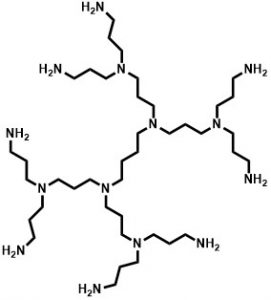SyMO-Chem has acquired Poly(propylene imine)-dendrimers (PPI-dendrimers), and sells these dendrimers to clients in research sample quantities. The amine terminated PPI-dendrimers of generations 1, 2 and 3 can be purchased. Below, the molecular structure of the second generation (G2) amine terminated PPI-dendrimer (or DAB-Am-8) is shown as an example:

Poly(propylene imine) dendrimers have also been called Astramol dendrimers, or have simply been abbreviated as PPI-dendrimers, or DAB-Am-x dendrimers. DAB stands for the diaminobutane core and x=4, 8, or 16 for the number of primary amine end groups associated with the generations 1, 2, or 3, respectively.
The molecular characteristics of the three existing generations of amine terminated PPI-dendrimers are given in the Table below.
| Dendrimer generation (G) | Molecular formula | Molecular weight (g/mol) | # primary amine endgroups | # interior tertiary amines |
| 1 | C16H40N6 | 316.5 | 4 | 2 |
| 2 | C40H96N14 | 777.3 | 8 | 6 |
| 3 | C88H288N30 | 1686.8 | 16 | 14 |
Apart, from selling the amine terminated PPI-dendrimers in research sample quantities, SyMO-Chem can provide you with other custom-made PPI-based dendrimers. It is also possible to set up a contract research project in the PPI-dendrimer chemistry field.
Prices and Quantities
Typical (and minimum) quantities and corresponding actual prices are:
| Dendrimer | Amount (g) | Price (€) |
| G1 PPI-dendrimer (DAB-Am-4) | 5 | 180 |
| 10 | 280 | |
| 25 | 550 | |
| G2 PPI-dendrimer (DAB-Am-8) | 5 | 250 |
| 10 | 425 | |
| G3 PPI-dendrimer (DAB-Am-16) | 5 | 400 |
| 10 | 650 |
Ordering
Contact us if you want to order, inquire about other quantities or other possibilities. We will then inform you on details and on the ordering procedure.
General information on PPI-dendrimers
Dendrimers are synthetic macromolecules with a well-defined, highly branched molecular structure that are synthesized in an algorithmic step-by-step fashion, with every repeated sequence of reactions producing a higher generation (G) molecule, with practically a doubled molecular weight and a doubled (discrete) number of functional end-groups. Since 1985, numerous chemically different types of dendrimers have been developed, such as Tomalia’s poly (amido amino) PAMAM-dendrimers, Newkome’s arborols, Fréchet’s poly ether dendrimers, Meijer and Mülhaupt’s poly(propylene imine) PPI-dendrimers and Moore’s phenylacetylene dendrimers. Because of their defined structure, narrow polydispersity, defined nanoscale size and the ease of modification of the end groups, dendrimers are considered interesting candidates for various functions in life sciences and medicinal chemistry. For example, their function as binding-and-release agents in drug and gene delivery has been investigated.
The following review, and references therein, can be consulted to know more about dendrimers in general, and about poly(propylene imine) dendrimers (PPI-dendrimers) in particular: A. W. Bosman, H. M Janssen, E. W Meijer, ChemRev, 1999, 99, 1665-1688.
Disclaimer – Warranty
The PPI-materials are intended and delivered for research purposes only, not for drug, household or other use, and are being supplied to the recipient with no warranties, express or implied, including any warranty of merchantability or fitness for a particular purpose. To the extent permitted by law, SyMO-Chem BV shall not be liable for any loss, claim, damage, or liability, of whatsoever kind or nature, which may arise from or in connection with the use, handling or storage of this material.
